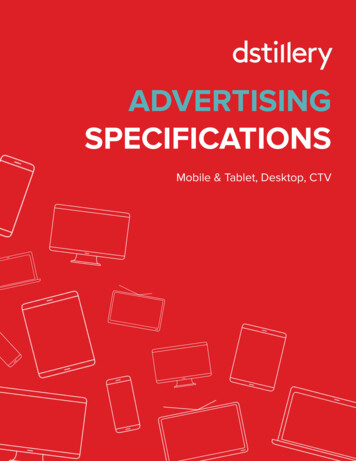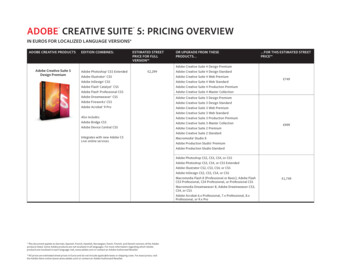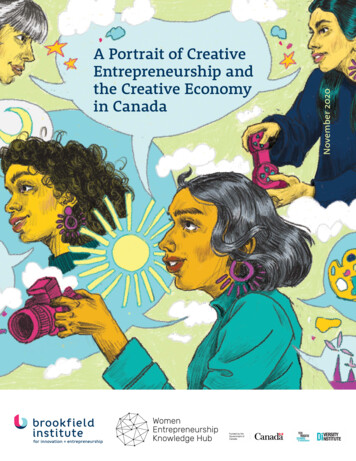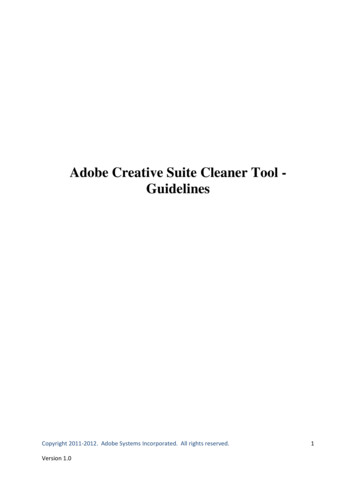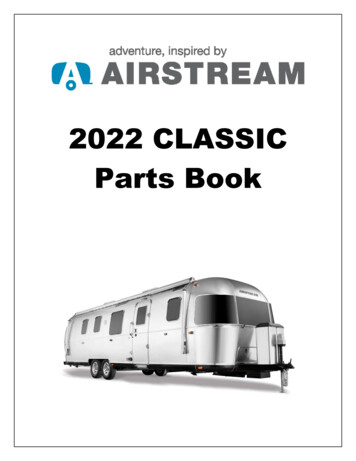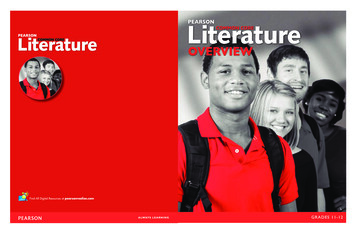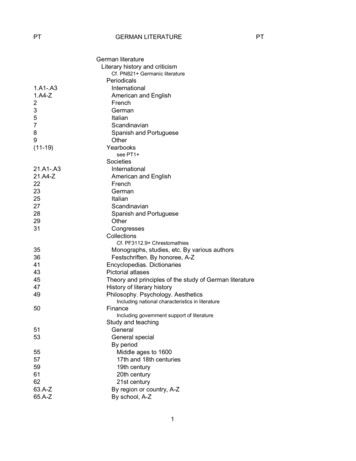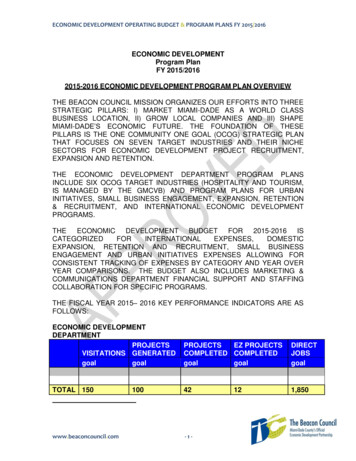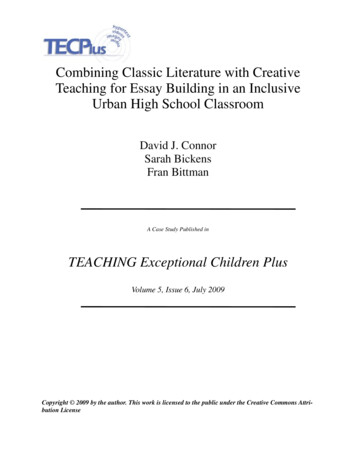
Transcription
Combining Classic Literature with CreativeTeaching for Essay Building in an InclusiveUrban High School ClassroomDavid J. ConnorSarah BickensFran BittmanA Case Study Published inTEACHING Exceptional Children PlusVolume 5, Issue 6, July 2009Copyright 2009 by the author. This work is licensed to the public under the Creative Commons Attribution License
Combining Classic Literature with Creative Teaching forEssay Building in an Inclusive UrbanHigh School ClassroomDavid J. ConnorSarah BickensFran BittmanAbstractThe urban inclusive high school classroom is a challenge for both students with disabilities and theirteachers. Pressure is intensified when a year long course of study ends in a mandated state examination in English Language Arts, required for student graduation. This article highlights the experiencesof two teachers in a New York City inclusive high school serving a very diverse student body. Bothteachers work collaboratively with special educators and share ways in which they successfully engage all of their students in a multicultural curriculum featuring both traditional and “modern classic”texts. Three important inter-connected topics addressed include: (1) discussing examples of classictraditional and multicultural literature; (2) creatively teaching classic literature to stimulate studentengagement and original thinking; and, (3) using student knowledge about classic literature to teachsub-skills necessary for writing a strong essay that will serve them well for the state mandated exam,and ultimately, in college.KeywordsHigh School, Inclusion, Strategies, Examinations, Learning DisabilitiesAcknowledgmentsWe would like to thank Christopher Lagares, Ryan Bittman, and Hector Geager for theirongoing support.SUGGESTED CITATION:Connor, D. J., Bickens, S., Bittman, F. (2009). Combining classic literature with creative teaching for essay building in an inclusive urban high school classroom. TEACHING ExceptionalChildren Plus, 5(6) Article 3. Retrieved [date] ol5/iss6/art3!2!
Introduction: The Challenge of theInclusive Urban High SchoolUrban high schools are often depictedas overcrowded, under funded, and markedby severe economic disparities. They alsohave a higher rate of ethnic, racial, linguistic,national, and religious diversity than theirsuburban and rural counterparts (Steinberg &Kincheloe, 2007). Many high schools in NewYork City, for example, are attended by a bustling, diverse body of students, largelyAfrican-American and Hispanic-American,with a sizeable number of Asian-Americanand European-American adolescents, many ofwhom are second generation or immigrants.When we add disability to the mix, this further diversifies what is already one of themost varied student populations in the world.Adolescents with learning problems, attentiondifficulties, behavioral challenges, and inneed of speech and language services, constitute over 75% of students with disabilities,and are the most likely students to be educated in inclusive settings (Hehir et al., 2005).It is worth noting that these students may alsobe English Language Learners (ELLs), considered “Gifted,” or “At Risk” for droppingout. Such endless potential for student diversity means that most urban high schools arelargely comprised of students who fit one ormultiple categories mentioned above.The shift over the last decade to increase standards, bolstered by the No ChildLeft Behind Act of 2002, means that all students must pass required state examinationsto obtain a high school diploma. To preparestudents for mandated exams, teachers areunder great pressure to provide rigorouscourses that increase student literacy skillswhile providing rich, relevant content. Although most students face significant challenges in navigating the statewide eleventhgrade English Language Arts (ELA) examina-tion, known as “The Regents,” those with disabilities that impact the process of learningface an even more formidable task.Manhattan Village Academy is onesuch school that faces the challenges of theinclusive urban high school. Every year theschool admits 9th grade students who varygreatly in their abilities, including studentswith learning disabilities (LD), AttentionDeficit Disorders (ADD) or Attention DeficitHyperactivity Disorder (ADHD), behaviordisorders (BD), as well as low incidencecategories such as hearing and speech impairments. At all grade levels teachers striveto ensure that students are meaningfully engaged in an interesting, academically demanding curriculum. In English LanguageArts classes, teachers introduce students toclassic and multicultural literature with aview toward giving them a good groundingfor college, a place they are assumed to attend. The ELA curriculum is perhaps no morechallenging than in eleventh grade, whereteachers are called upon to teach great literature and simultaneously instruct students inspecific skills of the essay-based, mandatedstate examination taken by students at the endof the year. Students must pass this exam inorder to graduate from high school.This article focuses on the work oftwo teachers working in Manhattan VillageAcademy who face these many challenges,and successfully engage their diverse studentbody in a multicultural curriculum featuringboth traditional and modern classic texts. Theteachers recognize that, as students movefrom adolescence into young adulthood, literature gives them a greater sense of history,provides them with increased knowledge ofthe world, and allows them an opportunity toreflect upon their place within it. Both teachers collaborate with the special educators atthe school to make sure students with indi!3!
vidualized education programs (IEPs) receiveadditional support both inside and outside oftheir classes. This model is seen as integral tothe success of students with disabilities (seeFigure 1).In subsequent sections, three important inter-connected topics are addressed: (1)discussing examples of classic traditional andmulticultural literature; (2) creatively teaching classic literature to stimulate student engagement and original thinking; and, (3) using student knowledge about classic literatureto teach sub-skills necessary for writing astrong essay that will serve them well for thestate mandated exam, and ultimately, in college.Figure 1: General and Special Educator Collaboration.The model to include students with disabilities at the school has several interlocking components thatensure their maximum support. Two special educators each work with two of the four high school gradelevels. While roles and responsibilities are extensive for both general and special educators, several important highlights are listed below:Special Educator Knows all curriculum being taught across ELA, history, math, and science Prioritizes which students need most assistance in general education classes, and works withcertain students in those classes Ensures that Individual Education Plans (IEPs) are implemented Works daily one-on-one and in small groups with students who have IEPs when students withoutIEPs provide community service and/or have job experiencesGeneral Educator Provides students with a rich curriculum Considers all students’ strengths and limitations in lesson planning Teaches using differentiated instruction Teaches an after school literary club that focuses on advanced texts Provides extra help classes after school to help all low performing students in reading comprehension and essay writingBoth Communicate information about specific students in an ongoing relationship with each otherProblem solve around actual or anticipated issuesParticipate in grade level meetings to discuss progress of all studentsParticipate in content area meetings, discussing core concepts and effective teaching strategiesfor whole class, small group, and individual studentsCommunicate with parents of studentsParticipate in after school support for students, including homework helpSelecting Classic and MulticulturalLiteratureThe value of multicultural literaturehas been long established (Banks, 1977,1993; Delpit, 1992; Gay, 1988; Nieto, 1992,1995). It serves to pluralize what has largelybeen a European-American Canon, offeringreaders a chance to vicariously experienceand learn from perspectives of people thatdiffer from their own cultural, social, and historical understanding of the world. In turn,previously marginalized or ignored groups arenow present and represented within the curriculum. However, counter arguments by cul!4!
tural theorists such as E.D. Hirsch (1988;1998) maintains that there is a traditionalcanon of literature that should be taught withview to providing citizens with common cultural referents. Our stance in this article is thatboth viewpoints can be accommodated because the United States has been, and in alllikelihood will remain, culturally diverse.Two texts in the eleventh grade American Literature course are F. Scott Fitzgerald’s TheGreat Gatsby (1925) and Richard Wright’sNative Son (1945). These books are chosen,in part, because they are particularly wellsuited to teaching the content, skills, and writing needed to excel on the ELA Regents Examination. While classics and creativity mayseem antithetical to the nature of high stakestesting, the engaging yet challenging nature ofthese novels motivates students as they striveto master the test. Moreover, teaching classicscreatively ensures that English class does notbecome simply a “test prep” factory.The Great GatsbyThe Great Gatsby is a classic American novel that centers around Jay Gatsby, awealthy and mysterious man living in LongIsland in the early 1920s. Gatsby’s secrets arerevealed through his neighbor, and the novel’snarrator, Nick Carraway. Nick’s subjectivepoint of view uncovers Jay’s dark past andhelps divulge Gatsby’s inner conflict. Themelodramatic climax of the novel alwaysspikes students’ interest and helps to crystallize the novel’s major themes.In its rather short 200 pages, TheGreat Gatsby brims with imagery and symbolism. A tale of the excesses and the corruption of wealth, this classic often initially intimidates high-schoolers and their teachers asthey attempt to find relevance in Jazz Ageromanticism and flowery language. However,questions of identity and the power of love–two issues with which nearly all teens struggle– lie below the surface of Gatsby’s lavishparties and Daisy’s superficial giggle. Whenrooted in these universalities, students quicklymake connections with the text and, withteacher guidance, learn to build their appreciation of the poetic descriptions.Native SonRichard Wright’s Native Son is thestory of Bigger Thomas, a young man whostruggles with racial oppression in 1930s Chicago. Bigger finally gets an opportunity for abetter future when he is hired as a chauffeurfor a wealthy white family, the Daltons. However, this opportunity is destroyed through analtercation with Mary, the Daltons’ collegeage daughter, during his first evening on thejob. For the remainder of the novel, Biggermust run from his mistakes and attempt toboth understand and justify his actions tohimself and to society.Native Son is a gargantuan text, boththematically and in actual size. It tackles issues of race, violence, and poverty in 1930’sAmerica over the course of almost 500 pages.As the first novel written by an AfricanAmerican to be selected by the Book of theMonth club in the 1940’s, it is both a Classictext and a work of ground-breaking multicultural literature. Despite its size and weightyplace in literary history, this text is a favoriteof students. Many urban teens experiencefirst-hand the conflicts of racism and the painof powerlessness and immediately identifyingwith the struggles of Bigger Thomas. Evenfor those students who may initially feel removed from the larger issues of race andpower, scenes of violence and the drama of amurder mystery told in approachable language quickly draw readers of varying abilities into the story.!5!
Providing Access to Texts by Teachingread, write, listen, and speak (Kagan & KaLiterature Creativelygan, 1998) (see Figure 10). By including aIn this section we focus on broadlyvariety of entry points into a task, classroomdefined creative approaches to teaching Theactivities allow all students to participateGreat Gatsby and Native Son and view thesefrom their position of strength. For studentsmethods as providing “access” to these textswho have significant difficulties in reading,for students with a range of abilities and disthe special educator has the option of workingabilities. By providing “access,” we do notwith abridged texts and recorded versions.mean literal physical entrée into classroomsWhen beginning any of these new(while obviously recognizing the importanceteaching and learning activities in a classof that), but rather the figurative challenge ofroom, a teacher should strive to introduceproviding multiple intellectual entry pointsthem effectively in a way that supports theinto the architecture of the curriculum. Thegrowth of student knowledge and skills. It ismethodology described in this section enimportant to note that instructional effectivegages multiple intelligences, skill levels, andness is maximized when teachers: (1) explainattitudes towards schooling and, inthe purpose of a strategy; (2) modeldoing so, allows for a broaderthe strategy, preferably “thinkingand more authentic “access” toaloud” to reveal their own perBy including alearning than in a more tradisonal thought process; (3) pracvariety of entrytional classroom. While sometice the strategy, leading the stupoints into a task,suggestions may appear textdents; (4) have students practiceclassroom activitiesspecific, all of these are generthe strategy, with teacher supallowallstudentstoalizable to other texts (see Figport as needed; (5) provide stuparticipatefromure 2 for a selection of otherdents with the time to practicetheir position ofpossible traditional and multi(Robb, 2000). In terms of introstrength.cultural classics). We acknowlducing a group activity, teachersedge that teachers should alwayscan prepare a group of studentsstrive toward providing engagingahead of time so they can demonactivities within literature lessons in order tostrate in a “fish-bowl” format, with their peersmaximize student “buy-in,” and at the samelooking on.time recognize the unrealistic ideal of teachers as entertainers in a perpetually fun enviFraming Essential Questionsronment. Providing all students with access toUtilizing the notion of “Backwarda text adheres to the tenets of universal designPlanning” developed by Wiggins andin education, namely creating lessons with allMcTighe (1998), teachers can formulate esstudents in mind, and therefore minimizingsential questions (EQs) that are used to framethe need to make accommodations retroaceach novel-based unit and help ground lestively (Hitchcock, Meyer, Rose, & Jackson,sons in “real-world” issues, answering the2002). This can be done in many ways, incommon student mantra, “Why are we learncluding incorporating at least two or threeing this?” Good EQs help adolescents withmultiple intelligences within every lessonLD, ADD/ADHD, and other academically(Gardner, 1983), and always providing sevstruggling students to remain focused oneral opportunities and choices for students tolarger themes and not get lost in minutia.!6!
When considering The Great Gatsby, questions could include: What is the AmericanDream? Is it possible to attain for everyone?What values were apparent in post World WarI America? In addition to these broad, overarching socio-historical issues, EQs can alsobe used to help promote deeper understandings of the nature of literature, such as: Howdoes the bias of a narrator influence a novel’sstory? or, How do relationships among characters contribute to the development ofthemes and plot? Oftentimes, the EQ cancombine both socio-historical and literarycraft, such as Native Son being taught withinthe EQ: Can literature fight injustice?Throughout the text, students debate issues ofjustice and injustice as they pertain to poverty, race, crime, urbanity, racism, and power,then debate this question after completing thenovel.Accountable TalkWhen reading any literature studentsmust be required to hold their ideas accountable to the specific text; in other words, theymust prove their claims through textual support (Huss, 2007). Moreover, students are encouraged to closely read key sections of thetext and consider the alternative or deeper interpretations that can come with careful literary analysis of symbols, metaphors, characterization, and imagery. These followingtechniques often have a creative hook or require hands-on participation, engaging students as they-- perhaps unknowingly at first-perform serious literary work.Marking up the text using Post-ItsThe “marking up” of texts is a simpleand valuable skill for students to master. Forstate exams and the Scholastic AssessmentTest (SAT), reading passages can be more ef-ficiently and effectively dissected when students are taught to underline main ideas, starimportant points, circle key dates and places,and write question marks near points of confusion (Connor & Lagares, 2007). This approach is particularly helpful for students whohave difficulty in comprehending a layeredtext as these symbols help them to focus onkey information. One way to encourage thisprocess without writing in a text is to havestudents use post-its to indicate important,surprising, or unclear information. This canthen be transferred to a graphic organizer designed to support claims in group discussionsor be used as evidence in writing essays.Small Group Work for Super Close ReadingIt is worth pointing out that many ofthe suggestions in this article are rooted in thevalue of group learning, a supportive processthat is sadly underutilized at the secondarylevel, considering the value and appeal of socialization to adolescents. For example, inreading texts, students can participate in several group activities that merit revisiting thetext to investigate symbols, imagery, or characterization. In these groups, students focuson a portion of a paragraph typically with acreative (and sometimes contrived) task inmind. For instance, each group member analyzes one small portion of the text, before thegroup comes together to use each person’scontribution to reach a final conclusionfounded in textual support. This type of groupwork automatically allows for differentiationas readers are allowed to self-select the sections of texts that they best understand to analyze. As the group shares their work, struggling readers are able to learn from modelingby more advanced peers (Gregory & Kuzmich, 2005).!7!
Figure 10: Connecting Suggested Strategies with Gardner’s Multiple IntelligencesStrategyEssential lyMusicalMathematic KinestheticIntraInter- Naturalistpersonal personalXXAccountable TalkXMarking the TextXXSmall Group/Close ReadXXXBio PoemXXXForging Historical ConnectionsXImagery/Creating VisualsXXExploring Media BiasXXXUsing the Crime SceneXXXCreating New BeginningsXPsychological Make UpXXGraphic Org: CharacteristicsXXCreative CulminationXXXSkill Building RoutinesXXXCritical LensXBasic StructureXXXIntro to EssayXMnemonicsXEssay PacketsXRubricsXOpportunity to Revise/RewriteXGroup EssayXRemoval of ScaffoldingXXXSupportive School RitualsXXXModern VersionsXTrialsXTown Council MeetingXTalk ShowXXPre-Reading: Historical DebateXXXMagazines/NewspapersXXXSilent DebatesXActing Scenes/LinesXXXPeer XXXXCharacter analysis: bio poemStudents can work in pairs or groupsof three and reread a small section of the textin which a character is first introduced. Afterwards, they create a bio-poem to describeXXXXXXXXXXXXXXXXXXXXXXXXXXXXXXthe character (For example, one model maycontain: three adjectives/I am /I think /Ifeel /statement or question, and so on). Foreach poem line, students pick out a quotationfrom the text that demonstrates their claim!8!
about the character. When they finish, groupscan “act out” their poem as their character,being sure to reflect traits revealed in a closereading of the text (see Figure 3).Figure 3: Character Analysis: Bio PoemFirst nameResident of Child of Brother/Sister of 3 adjectives to describe appearanceI look like .3 adjectives to describe personalityKey quotation that shows personalityI feel I hate I love I dream I give Some day I will be 3 different adjectives to describe characterLast NameDaisyResident of East EggChild of privilegeSister of wealthAiry, shining, blondeI look like an expensive piece of jewelrySuperficial, humorous, flippantHer voice had “promise that she had done gay, exciting things just a while since and that there were gay, excitingthings hovering in the next hour” (14).I feel exhaustedI hate povertyI love to laughI dream that my life will never changeI give my allure to those around meSome day I will be sorryCareless, self-absorbed, addictiveBuchananThe setting: forging historical connectionsStudents simultaneously studyingUnited States history, or who have a previousbackground in American history, benefit fromengaging with the context of the novel (Marzano, 2004). However, for those who lacksufficient prior knowledge, an effort shouldbe made to help define the specific time period to aid in students’ understanding of thetext. For example, before beginning NativeSon, students can participate in a jigsaw activity where different groups read and analyzeinformation about Richard Wright’s own family, Wright’s philosophy, the creation of Big!9!
ger, and Bigger’s place in society, can help setup students for the role of setting in the novel.During Bigger’s first night on the job, the historical Scottsboro case is mentioned, offeringthe opportunity to use actual articles about thecase and discuss other controversial trials thatoccurred during the time period. A closingdebate can tie together much of past historywith the present by posing questions such as:Is Bigger’s crime justified? What kind of discrimination still separates different groupsinto unfair roles in society? Which cases incontemporary society remind you of Bigger’s?Imagery analysis: creating a visualOftentimes, the sheer amount of detailin novels such as The Great Gatsby overwhelms students. However, a close readingcan “slow down” teens and allow them torevel in the beauty of Fitzgerald’s language.Pairs of students can be assigned a paragraph,such as the description of Gatsby’s party.Working together, they draw the scene, incorporating as many details as possible. For eachdetail, the students include a line or wordsfrom the text that “inspired” their artistic interpretation. As students draw and label thescene, they begin to realize how the imageryand figurative language used by Fitzgeraldworks to paint a picture within the reader’shead (Levine, 1994). Students can then sharetheir pictures with the class, explaining howtheir interpretation of the text allowed them toarrive at their final visual representation. After pairs complete this work, the pictures canbe arranged in the order they appear in thenovel, thus creating a detailed visual “timeline” for the story.Exploring media biasMany students are already well awareof how the media influences public opinion,and discussions about how the media worksmay bring fresh angles to understanding anystory (Gorham, 2006). In depicting public reaction to the murder of a white heiress by apoor black man, Wright includes newspaperheadlines and articles covering Bigger’s flightfrom the law. The bias in this reporting is obvious; Bigger is up against a societal racismmuch larger than himself. One small groupactivity requires students to explore how themedia within the novel expresses bias, as wellas making connections to ways in which biascan be detected in contemporary reporting. Inthis activity, students also practice usingterms such as diction and tone as they analyzelanguage to find bias within it. First, smallgroups re-read a section of the reporting ofthe murder and flight. Second, they record theword choice that may indicate bias and decideupon a tone for the scene. Third, using actualquotations from their close reading, studentspresent a nightly news report of the BiggerThomas “Flight from Justice.” While this activity must be closely monitored to preventoffensiveness, it forces students to examine apassage on the “word level” in detail and consider the implications of diction chosen by themedia. Finally, students look at modernnewspaper headlines and article biases theysee existing today.Using a crime scene investigation to makepredictionsThis activity asks students to considerthe many details and plot twists included in acrime scene, often a pivotal part of a novel. InNative Son, for example, Bigger Thomascarelessly disposes of the evidence from hismurder. Students work in groups to take onthe role of crime scene investigators and reread the description of the cover-up from thisperspective. Then, using textual evidence, thestudent detectives draw conclusions from the!10!
scene, predicting how Bigger’s crime will bediscovered. The analogy of the crime sceneinvestigator reminds students of the need tonotice small details in the text, and then usetheir predicting skills to anticipate future plotaction (Harvey & Goudvis, 2000).Creating new beginningsWorking in small groups, students canchoose a character to reinvent, and create anescape plan from the novel’s setting thatwould allow the character to be free and aliveat the close of the book. For example, in Native Son, Bigger or Bessie are characterswhose fates can be reinvented. A worksheetmay guide students with useful questionssuch as: Where should he/she go? Whatshould he/she do? How will he/she get there?How will he/she do this? How will he/shesupport him/herself when he/she gets there?What should Bigger do about Bessie? Whatshould Bessie do about Bigger? What eventscould happen that would ruin this plan?Figure 4: Basic Organizer: Focusing on a Character’s Psychological Make Up!"# %&'( ))&* #',&-%Name:!!11!
Basic Organizers: Focusing on a Character’sPsychological Make UpIn a very demanding curriculum,sometimes a simple basic organizer is the keyto helping students temporarily focus on specific incidents within the book (DiCecco &Gleason, 2002). By providing students with aworksheet containing a physical image ofBigger with a thought bubble, they can be encouraged to write draw or write what theybelieve to be the major conflicts and thoughtsgoing through his head (see Figure 4).Using graphic organizers for logs: characterization and conflictConflict, characterization and themeare inextricably tied together within NativeSon and can all be addressed together.Through the use of logs, students can chartBigger’s emotions in conjunction with theevents in the plot, and see the specific conflicts in his life (Andersen, Yilmaz, &Washburn-Moses, 2004). For each majorchoice Bigger is forced to make, both sides ofthe conflict must be addressed--as well as therationale for why Bigger makes his decision.The logs should help guide students to engagewith the change in Bigger’s character, evidentwithin his action and the consequences ofthose actions (see Figure 5).Figure 5: Using Graphic Organizers for Logs: Character EvolverBigger ThomasEventQuote / Page #Characterized as Change?Violent, aggressive, pow- Bigger woke up sleepy,Bigger wakes up in his fam- “Bigger took a shoe andpoundedtherat’shead,crushingerful, psychological prob- but when threatenedily’s apartment and kills a rat.it, cursing hysterically” (6).lems?sprang into violent action.Bigger has hopes anddreams. He wishes to be apilot.“Let’s play ‘white,’” BiggerSad that his world is sosaid, referring to a game. “Itlimited. Angry?don’t help none,” Gus said (17).He fantasizes, but in theend knows he cannotachieve his dreams in thesociety of that time.Bigger meets the Dalton fam- “This was not his world. HeConfused, naïve, segreily.was foolish in thinking hegated, powerless, tense,would have liked it His jaw angry.clamped tight He wanted tostrike something with his fist”(44).Bigger seems weaker inthe “white world;” However, his weakness bringsout anger/violence seenbefore.Creative CulminationsAfter finishing a novel, there shouldbe a cumulative activity or project. Studentscan work in groups with a choice of severalroles and, as in other group work, this structure allows for a differentiation of tasks. In!12!
addition to reviewing skills and content in adifferentiated fashion, these creative culminations are often simply enjoyable, funny, andexciting as students get to act, laugh, and argue. As a result, participating in these activi-ties makes the novels “stick” with students;the more students remember books, the morelikely they will be able to use these books onstate exams and as guidance for life (See Figure 6 for several examples).Figure 6: Creative CulminationsExample #1: The Great Gatsby – A Parallel ProjectThe story of Gatsby--a man who came from nothing and constructed a life to win over the woman heloved--has been referenced throughout literature and in modern pop culture as the quintessential AmericanDream. For this project students work in pairs to create a modern Gatsby: a man (or woman) with a dream whocreates a version of himself but, when faced with an antagonist and defeat ultimately fails. As students write aGatsby story, they review and then borrow from Fitzgerald’s tropes. Students create a symbol of the dream (theirown “green light”), an antagonist (their own Tom Buchanan), a symbol of the dream’s failure (their own “valleyof ashes”), and a tragic ending (their own version of Gatsby’s empty funeral). After creating their story, studentsthen write a small scene in which their “Gatsby” and the antagonist clash. This scene
Native Son is a gar gantuan text, both thematically and in actual size. It tackles is-sues of race, violence, and poverty in 1930Õ s America over the course of almost 500 pages. As the first novel written
